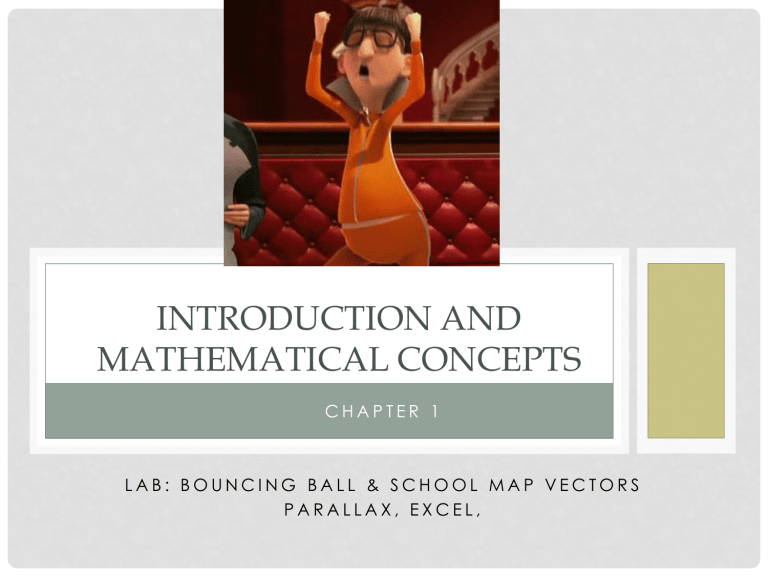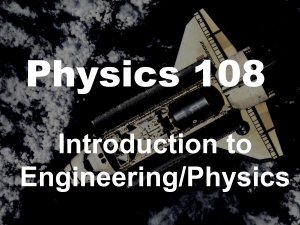Intro Ppt - Marchman AP Physics

INTRODUCTION AND
MATHEMATICAL CONCEPTS
C H A P T E R 1
L A B : B O U N C I N G B A L L & S C H O O L M A P V E C T O R S
P A R A L L A X , E X C E L ,
1.1 THE NATURE OF PHYSICS
What is Physics?
• The study of the fundamental laws of the universe.
• The laws that underlie ALL physical phenomena in the universe
• The study of everything… and nothing
THE ROLE OF MATHEMATICS
• Math is the language of physics.
• The properties of the universe can be modeled perfectly (for all practical purposes) by mathematics.
• In AP Physics 1, we are more concerned with what these formulas mean and what they tell us about the universe than what sorts of things we can simply ‘plug’ into them.
THE 4 FUNDAMENTAL FORCES
• From strongest to weakest…
S
trong Nuclear (10,000)
E
lectromagnetic (100)
W
eak Nuclear (0.01)
G
ravity (10
-34
)
THE FOUR FORCES
• Strong Nuclear –
The force that hold the protons together in the nucleus
• Electromagnetic –
The force of life, lightning/electricity, magnetism
• Weak Nuclear –
Radioactivity, when nuclei break apart
• Gravity – weakest force in the universe but it can build up to be the strongest force in the Universe
(Black Holes)
HOW MECHANICS CONNECTS: (YOU
CAN DO THE SAME THING USING
CHARGE INSTEAD OF MASS)
1. Mass
2. Distance
3. Time
4. charge
The Conservation
Laws
1. 𝑣 = 𝑡
2. 𝑎 = 𝑡
3. 𝐹 = 𝑚𝑎
Impulse/Momentum
J = 𝐹 𝑡 =
𝑚𝑣 = p
F
d Work/Energy
(F and d are
PARALLEL)
W = 𝐹 d
P =
𝑊 𝑡
orque (F and r are
PERPENDICULAR)
= 𝐹
r = 𝐫
𝐅
THE 4 FORCES PUSH OR PULL
• Matter & Energy
• Linear Momentum
• Angular Momentum
• (These are the conserved quantities)
1.2 UNITS
• Metric Prefixes
• Sig Figs. (practice problems)
• Why do we need Sig fig’s?
METRIC SYSTEM… WHAT IS IT?!
• Standard system of measurement
• Why is it important to have a ‘standard system’?
• Base Units
• Length = meter
• Mass = gram
• Time = __________?
• Based on units of 10
METRIC REVIEW
Metric Base Units
Length
Mass
Volume
Time
meter (m) gram (g)
Liter (L) second (s)
Note: In physics the kilogram (kg) is used as the fundamental unit for mass not the gram.
THE INTERNATIONAL SYSTEM OF
MEASUREMENT (SI) - METRICS
King Henry Died (by) D rinking C hocolate M ilk
____ ____ ____ ____ ____ ____ ____ k h da (base) d c m
THE PREFIXES – POWERS OF 10
• kilovalue
1000
• hecto100 symbol k
•
• deka10
• BASE deci-
1 h da m, l, g
1/10 (0.1) d
• centi1/100 (0.01) c
• milli1/1000 (0.001) m
To change between units, multiply or divide by powers of
10, or simply move the decimal point to the left or right
Can you think of any words that have these prefixes?
METRIC THOUGHTS
G * * M * * k h da ---d c m * * µ * * n
Giga Mega base micro nano
If you are converting this way… You should be
adding 0’s i.e. move decimal right
If you are converting this way… You should be
subtracting 0’s i.e. move decimal left
1.3 THE ROLE OF UNITS IN PROBLEM
SOLVING
• Learn your units! They will make your life easier than you will ever know.
• Without units, your numbers are
meaningless!
• 1999 NASA Probe launch lost in Mars’ atmosphere
• Engine engineers working in British units
• Scientists controlling engines working with SI units
BASIC DIMENSIONS
• Length/Distance [L]
• Time [T]
• Mass [M]
• Charge (this comes later)
DIMENSIONAL ANALYSIS
• If I have a box whose volume is 4.75 m 3 , how can I express the volume of the box in terms of centimeters?
Conversion Factor:
1 𝑚𝑒𝑡𝑒𝑟
100 𝑐𝑚
Volume has units of cm 3 cm = [L], so volume has dimensions of [L] 3
DIMENSION
Determine the dimensions of…
AREA –
VELOCITY –
CHALLENGE
• How many times does your heart beat per year?
WHAT’S A ‘SIG FIG’?
• The number of figures known with some reliability.
HOW TO TELL
1.
All non-zero digits are significant
2.
Zeroes between non-zeroes are significant.
3.
Zeroes to the LEFT of the first non-zero number are NOT significant.
a) 0.0012 has 2 significant figures.
4.
Zeroes to the right of a decimal point are significant.
a) 12.40 has 4 sig. Figs.
5.
Zeroes that simply “hold the place”are not significant.
a) 123000 has 3 significant figures.
SIG FIG PRACTICE
HOW MANY NUMBERS ARE SIGNIFICANT IN:
1
1.0
1 sig fig
2 sig fig
1 sig fig
0.1
0.01
1 sig fig
0.010
2 sig fig
1.02
1000
1001
3 sig fig
1 sig fig
4 sig fig
SCIENTIFIC NOTATION
WHY???
• To show numbers that are very large…Or very small.
• There are about 200,000,000,000 stars in the
Andromeda Galaxy
• (2.0 x 10 11 Stars)
• Alpha particle from Plutonium 239 decay is
0.000,000,000,000,000,000,000,000,006,645 kg
• 6.645 x 10 -27 kg
RULES
• General format is M x 10 N where 1≤M<10 and N is an integer (+ is a large number,
− is a small number)
Examples
5800 m = 5.8x10
3 m
0.003600 kg = 3.6x10
3 kg
302,000,000 = 3.02x10
8
0.004 = 4.0x10
-3
• For adding, subtracting, division, and multiplication, use your calculator.
TRY THIS
•
(1.5x10-2 N)x(9.2x103 m)
Enter in your calculator…
“(1)(.)(5)(EE or EXP)(-2)(x)(9)(.)(2)(EE or EXP)(3)(=)”
• DO NOT USE “x 10 ^” this can lead to math errors!!
WEBASSIGN
• www.webassign.net
• Don’t stress over WebAssign!
• Don’t spend more than 15 minutes on a problem especially if you’re getting nowhere!! (you’ve got better things to do with your life than physics problems)
• We will make every effort to go over each problem in class
• Work WITH your classmates!
THE NATURE OF PHYSICAL
QUANTITIES
• ‘magnitude’ means the same thing as ‘absolute value’
• A ‘vector’ is a made-up math tool physicists use for making calculations much easier
• A ‘vector’ has magnitude (length) and points in a direction, similar to a ‘ray’ in geometry.
Vector Vocab
Normal Person Physics Person
Arrow
Length
Direction
Hypotenuse
Legs
Vector
Magnitude (no neg’s)
Direction (+/-)
Resultant
Components
3-1 Scalars Versus Vectors
Scalar: number with units
Vector: quantity with magnitude and direction
How to get to the library: need to know how far and which way
3-2 The Components of a Vector
Can resolve vector into perpendicular components using a twodimensional coordinate system:
3-2 The Components of a Vector
Length, angle, and components can be calculated from each other using trigonometry:
3-3 Adding and Subtracting Vectors
Adding vectors graphically: Place the tail of the second at the head of the first. The sum points from the tail of the first to the head of the last.
3-3 Adding and Subtracting Vectors
Adding Vectors Using Components:
1. Find the components of each vector to be added.
2. Add the x - and y -components separately.
3. Find the resultant vector.
3-3 Adding and Subtracting Vectors
Subtracting Vectors: The negative of a vector is a vector of the same magnitude pointing in the opposite direction. Here, D = A –
B.
3-4 Unit Vectors
Multiplying unit vectors by scalars: the multiplier changes the length, and the sign indicates the direction.
1.6 VECTOR ADDITION AND
SUBTRACTION
• There are 3 ways scientists like to do vector addition:
• Parallelogram method (only works for 2 vectors at a time! And they share the same tail)
• Tip-to-Tail (works for any number of vectors! And they are connected tip-to-tail)
• Component method (works for any number of vectors and you don’t have to connect, just count)
#1
Parallelogram method
#1
START
FINISH
Tip-to-Tail method
Slope: -1
Angle: -45º
#1 START
FINISH
Tip-to-Tail method
Slope: -1
Angle: -45º
#2
Tip-to-Tail method
START
FINISH
Slope: 0
Angle: 0º
#3 START
Slope: -1
Angle: -45º
FINISH
This is the Tip-to-Tail method of connecting vectors. The Order in which you connect the vectors DOES NOT MATTER! (Vector
Addition is commutative just like adding numbers!)
#3
START
Slope: -1
Angle: -45º
FINISH
In Tip-to-Tail you always draw your resultant vector from where you START pointing to where you FINISH!
#4
START
FINISH
Slope: und
Angle: -90º
#5
Slope: und
Angle: -90º
The order that you connect them in does not matter!
Try it!
#5
This should be our answer!
Slope: und
Angle: -90º
The order that you connect them in does not matter!
Try it!
#6
Slope: -1
Angle: 135º
#7
Slope: -4
Angle: -76º
Use trigonometry and vector components to calculate the direction (angle) of the resultant vector.
#8
Slope: -3/4
Angle: -37º
#9
Slope: -3/8
Angle: -20.6º
#10
Slope: und
Angle: none
#11
Slope: und
Angle: none



